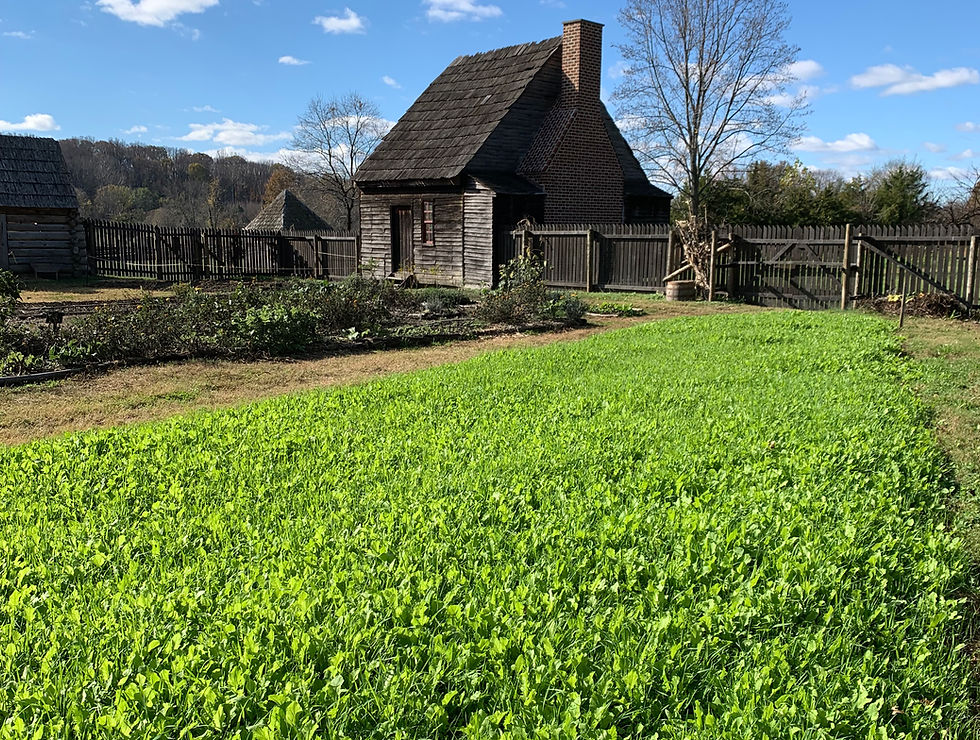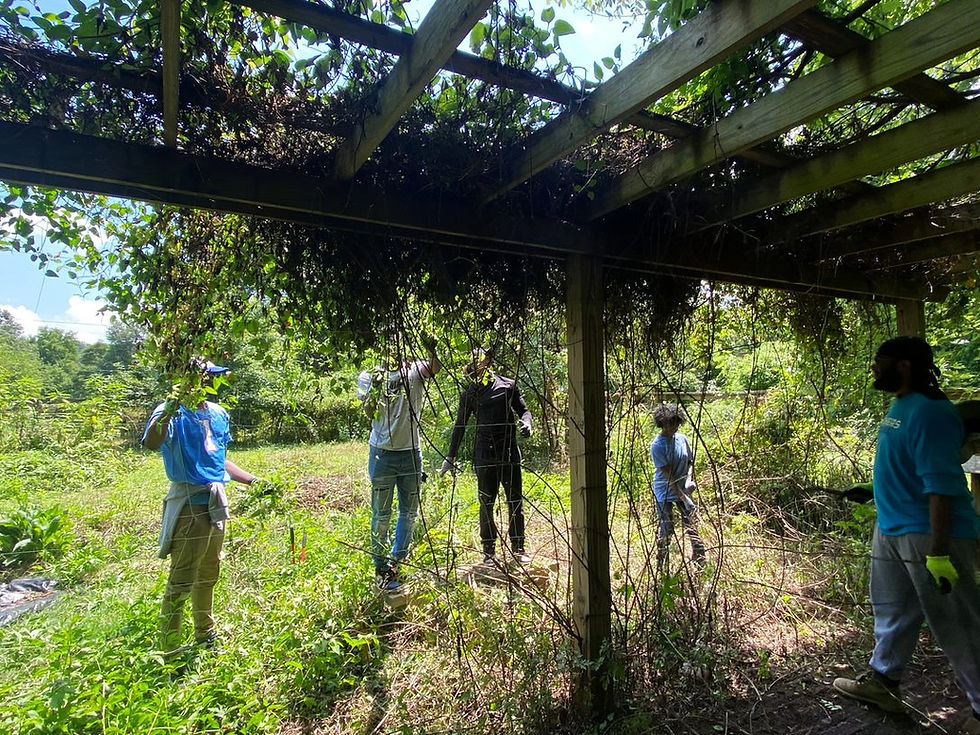Field Notes: Volume 16, Number 3
- Accokeek Foundation

- May 20, 2011
- 4 min read

This Week’s Harvest
Cilantro
Scallions
Pea Vine
Green Garlic
Salad Mix
Head Lettuce or Pak Choi
Summer Squash
While we strive for consistency at the Ecosystem Farm, we ask that our SHAREholders please keep in mind that Friday and Tuesday harvests will not always be the same.
For your convenience, an exact harvest list will be posted in the packing shed.
As the season quickens, the atmosphere of the Ecosystem Farm has experienced a positive shift. The garlic have sent up scapes, flower stalks that will soon make their way into our harvests. The summer squash have grown in size, as the staff hand-pollinates the greenhouse-dwelling plants that are screened off from predators and pollinators alike, calling for human hands to do the work of bees and butterflies. And a pair of Prothonotary Warblers have been found nesting in the packing shed, so be on the look-out for the bright yellow birds when you come to the site to pick up your SHAREs (but don’t confuse them with the House Sparrows that are nesting nearby).
Even the farm staff has developed a more positive outlook on the season that lies ahead. This week, the staff met with former manager Shane LaBrake, ever-knowledgeable and helpful in acclimating these three new-to-Accokeek farmers with the place that he helped to build. Shane was the first manager of the Ecosystem Farm, and has returned to the site to help the staff get things in order, offering his perspective on the land’s past and present and encouraging them to come to an understanding rather than an impasse. A well-known quote from Theodore Roosevelt has inspired both Shane and the staff: We must do what we can, with what we have, where we are.
As the four farmers opened up a new channel of communication, the call of the yellow-billed cuckoo rang out. The common but quite elusive bird (its call is heard more often than the creature is seen) is often considered to signal a turn of fate. Whether it is a good turn or a bad turn, we suppose it is up to the staff to decide. And they, of course, are ever the optimists.
Up Close With Cilantro
Cilantro: people love it, and people hate it. Even the New York Times has written about the divisive nature of this green, feathery plant, inspiring as it does “a primal revulsion among an outspoken minority of eaters.” In Why Cilantro Tastes Like Soap, For Some, Harold McGee writes of a widespread phobia of the coriander plant. What is so popular in Asia and Latin America is so hated elsewhere. Even Julia Child said in an interview with Larry King that, if she were to find cilantro on her plate, she would “pick it out” and “throw it on the floor.”
Writes McGee:
Ms. Child had plenty of company for her feelings about cilantro … The authoritative Oxford Companion to Food notes that the word “coriander” is said to derive from the Greek word for bedbug, that cilantro aroma “has been compared with the smell of bug-infested bedclothes” and that “Europeans often have difficulty in overcoming their initial aversion to this smell.” There’s an “I Hate Cilantro” Facebook page with hundreds of fans and an I Hate Cilantro blog.
Indeed, “modern cilantrophobes” often complain of the herb’s smell and taste, so reminiscent of soap. But McGee notes that a recent Japanese study suggests that the plant can be “reshaped to make it easier to take,” that the leaves can be crushed to get rid of this soapy smell. So below, we’ve included a recipe for cilantro pesto, which we hope will bridge the great cilantro gap.
Below, photos from this week on the Ecosystem Farm. Click images to enlarge, or view them on Flickr.
This Week’s Recipe: Cilantro Pesto
Recipe from the Seasonal Chef
Ingredients:
3 cups loosely packed cilantro leaves, washed and dried
1/2 cup grated parmesan cheese
1/2 cup roasted pine nuts, walnuts, or other nuts
2 cloves garlic
Juice one lime
1/2 cup extra virgin olive oil
1/2 teaspoon sea salt, or to taste
1/4 teaspoon black pepper, or to taste
Directions:
Strip cilantro leaves from stems and set aside. Coarsely chop the stems and place in food processor or blender.
Add cheese, nuts, garlic, lime juice, olive oil, salt, and pepper and process to a uniform consistency.
Add cilantro leaves and process until leaves are coarsely chopped.
Upcoming Events
Organic Gardening Workshop: Soil and Compost: Saturday, May 21, 2011, 10 a.m. to 12:30 p.m., Education Center: Improve your garden’s health from the bottom up. This course–part of our season-long Organic Gardening Workshop Series geared toward backyard gardeners–will provide you with the information needed to build your soil fertility. We will discuss how to test and improve your soil, how to construct a backyard compost pile, and how to feed the plants that will soon feed you. We will also discuss how to compost with worms.
Monthly Foodways: Where’s The Beef?: Saturday, May 21, 2011, Noon to 1 p.m., National Colonial Farm: Join us for a kitchen table conversation as we introduce you to the epicurean delights of colonial Marylanders. Learn how our tastes and the food itself have changed over 300 years as we explore the “receipts” (recipes) and meal preparation for everything from peas and pottage to food traditions for which Maryland is known. This month’s theme is “Where’s the Beef?” featuring Curing beef, a pretty dish of a breast of venison, a visit from our friends at the National Museum of the American Indian who will present some of their Nation’s culinary traditions, and Muskrat Love!
Film Series: The Last Boat Out: Tuesday, May 24, 2011, 6:30 to 9 p.m., Education Center: From learning about the lives of America’s young farmers to watching a waterman work the waters of the Chesapeake Bay, come see stories of sustainable agriculture and environmental conservation unfold on the silver screen. Our six-part documentary film series includes movies like FRESH, The Plow That Broke the Plains, and The Future of Food. This month, we will show The Last Boat Out, a film that weaves together the tales of a battered Chesapeake Bay and a family of watermen struggling to preserve their way of life. Narrated by actor and activist Sam Waterston, the film is a story of human determination and hope in the face of past mistakes.
Ecosystem Farm Volunteer Day: Recurring, Second and Fourth Thursdays, 1 to 4 p.m., Ecosystem Farm: Volunteers will join the farm crew in their work and, in the process, learn about organic and sustainable agricultural practices. Please wear appropriate clothing, including long pants, sturdy shoes or boots, sunscreen and/or a hat. Bring snacks and a refillable water bottle. Work will vary depending on the weather.







